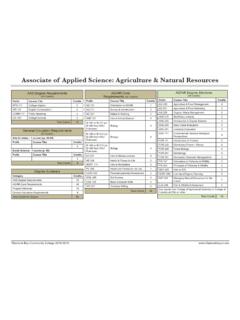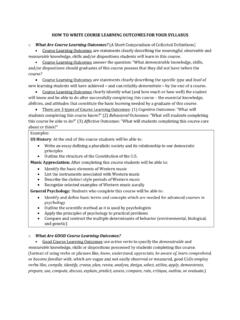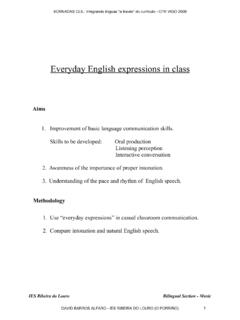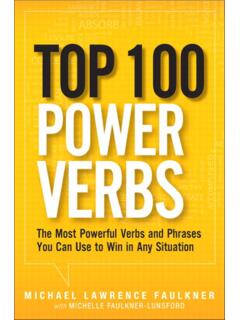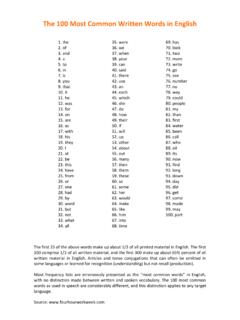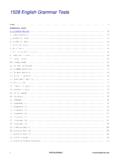Transcription of Tiered Sentence Combining
1 Tiered Sentence Combining Strategies and exercises for Combining short sentences with and, but, or, so Developed by: Marn Frank ATLAS Literacy Coordinator August, 2014 This project was contracted and funded by the Adult Basic Education Teaching and Learning Advancement System (ATLAS). Housed at the Hamline University School of Education, ATLAS is made possible with a grant from the Minnesota Department of Education using federal funding, Workforce Investment Act of 1998 ( 105-220), CFDA and Minnesota Statute Tiered Sentence Combining , ATLAS, 2014 2 Purposes and Acknowledgements Tiered Sentence Combining is the result of contributions from Minnesota Student Achievement in Reading (MN STAR) participants over several years. It is intended to improve integrated reading/writing skills such as: 1.
2 Sentence composition: writing grammatically and mechanically correct sentences 2. Sentence complexity: writing longer and more mature sentences 3. Sentence comprehension: understanding meanings of combined sentences 4. Usage and understanding of Tier 1 (sight) and Tier 2 (academic) words found frequently in print materials at Beginning and Intermediate levels, respectively. A special THANK YOU to Kristine Kelly, STAR trainer/teacher, for her patience and guidance in the long development of this resource. A sincere THANK YOU to MN STAR 09/10/11/12 Sentence topic contributors and piloters* listed below in alphabetical order. Jeanne Amundson Paul Amundson Penny Brown Donna Escobedo* Kirsten Fuglseth Margaret Genereux* Sue Henkel Nancy Johnson Katie Kruger Ruth Lanquist Lynn Larson Rebecca Lee-Hunt Kathy Lundquist* Linda Melin Pam Moriarty* Vicki Ostrom* Jeanne Plack* Bill Rasmussen Meg Roeske Catherine Ryan Sherri Smith Ruth Stevens LeeAnn Triden Christine Wytaske Mark Zosel Anonymous Any questions or comments about this resource should be directed to Marn Frank at: Tiered Sentence Combining , ATLAS, 2014 3 Table of Contents Page/Pages Teacher Background A - E A.
3 Evidence Base and Readiness 5-6 B. Word Tiers 7 C. Sentence Terms 8 D. Sentence Types 9 E. Simple Sentence Structures 10-11 Explicit READ-WRITE-READ Process 12-13 Strategy One: Teacher Information (and) 14 Strategy One: Student Exercise 1 15 Strategy One: Student Exercises 2A & 2B 16-17 Strategy One: Student Exercise 3 18 Strategy One: Student Exercises 4A & 4B 19-20 Strategy One: Student Exercise 5 21 Strategy One: Student Exercises 6A & 6B 22-23 Strategy One: Answer Key 24-25 Strategy Two: Teacher Information (and) 26 Strategy Two: Student Exercise 7 27 Strategy Two: Student Exercises 8A & 8B 28-29 Strategy Two: Student Exercise 9 30 Strategy Two: Student Exercises 10A & 10B 31-32 Strategy Two: Student Exercise 11 33 Strategy Two: Student Exercises 12A & 12B 34-35 Strategy Two.
4 Answer Key 36-37 Strategy Three: Teacher Information (but) 38 Strategy Three: Student Exercise 13 39 Strategy Three: Student Exercises 14A & 14B 40-41 Strategy Three: Student Exercise 15 42 Strategy Three: Student Exercises 16A & 16B 43-44 Strategy Three: Student Exercise 17 45 Strategy Three: Student Exercises 18A & 18B 46-47 Strategy Three: Answer Key 48-49 Tiered Sentence Combining , ATLAS, 2014 4 Table of Contents Page/Pages Strategy Four: Teacher Information (and, but) 50 Strategy Four: Student Exercise 19 51 Strategy Four: Student Exercises 20A & 20B 52-53 Strategy Four: Student Exercise 21 54 Strategy Four: Student Exercises 22A & 22B 55-56 Strategy Four: Student Exercise 23 57 Strategy Four: Student Exercises 24A & 24B 58-59 Strategy Four: Answer Key 60-61 Strategy Five: Teacher Information (or) 62 Strategy Five: Student Exercise 25 63 Strategy Five: Student Exercises 26A & 26B 64-65 Strategy Five: Student Exercise 27 66 Strategy Five: Student Exercises 28A & 28B 67-68 Strategy Five: Answer Key 69 Strategy Six: Teacher Information (so) 70 Strategy Six: Student Exercise 29 71 Strategy Six: Student Exercises 30A & 30 B 72-73 Strategy Six: Student Exercise 31 74 Strategy Six: Student Exercises 32A & 32 B 75-76 Strategy Six: Answer Key 77-78 Practical Ideas from the Author and Practitioners 79 References 80 Tiered Sentence Combining , ATLAS, 2014 5 Teacher Background A.
5 Evidence Base Sentence Combining , a writing intervention that teaches students to combine words, phrases, and clauses from short sentences into longer and more complex sentences , is not a new instructional idea. It was actually created in the 1960s but not used widely despite strong evidence supporting its effectiveness (Saddler, 2005, 2008, 2010). The value of Sentence Combining for reading/writing instruction resurfaced recently in two national publications for adult literacy. Just Write! Guide from Teaching Excellence in Adult Literacy (TEAL, 2011) identifies research-based instructional practices in the content area of writing. One of the recommended writing interventions is Sentence Combining : an alternative to traditional grammar instruction [that] holds greater promise for students to produce quality writing (p.)
6 36). The authors mention that ABE students writing can be monotonous because they often use the same Sentence structures repeatedly. Sentence Combining instruction helps them write sentences that are more complex, interesting, sophisticated, and varied in structure. They recommend the explicit instruction sequence, where each Sentence Combining strategy is introduced with teacher modeling, followed with teacher-guided practice, and when students are ready to be released, independent Sentence Combining exercises. Developing Reading and Writing, a summary booklet based on Improving Adult Literacy Instruction: Options for Practice and Research from the National Research Council (NRC, 2012), defines literacy as both reading and writing and recommends an integrated system of skills. Reading and writing depend on similar knowledge and cognitive processes, so insights in one area can lead to in the other.
7 Making this relationship explicit will aid learners skill development, contribute to their awareness about language, and enhance their retrieval of text forms and meanings (p. 15). The authors list ten key practices with potential to develop writing skills (p. 16). Sentence Combining is number six in rough order of effectiveness: 1. Offer instruction in strategies for planning, revising, and editing compositions. 2. Teach learners to summarize in writing the passages they have read. 3. Enable the assistance of peers in planning, drafting, and revising compositions. 4. Set clear goals for writing that are specific to the purpose and type of writing task. 5. Have students regularly use computers for writing instead of only paper and pencil. 6. Offer instruction in Combining short sentences into more complex ones.
8 This practice usually includes exercises and application to real-world writing tasks. Tiered Sentence Combining , ATLAS, 2014 6 Tiered Sentence Combining is based on these sources of evidence in the following ways: It offers strategies and exercises for Combining short sentences into longer, more complex ones. It recommends an explicit and integrated instructional process: READ-WRITE-READ. It presents real-world Sentence topics suggested by MN STAR participants. It can be applied to student-written sentences and paragraphs. In addition, the strategies and exercises are similar to certain 2014 GED Reasoning Through Language Arts test items on Sentence fragments, run-on sentences , fused sentences , subject-verb agreement, capitalization and punctuation. They also align with several developmental skills from College and Career Readiness Standards for english Language Arts and Literacy, Language Standard, CCR Anchor 1: Demonstrate command of the conventions of standard english grammar and usage when writing or speaking.
9 Sentence Combining Readiness Teachers are encouraged to select from the Sentence Combining strategies and exercises according to students language/reading/writing skills and motivation. The following student factors indicate possible readiness: At least basic english speaking, listening, and conversational skills At least basic reading skills (approximately NRS levels Beginning ABE+ or Intermediate ESL+) At least basic Sentence writing skills Desire and willingness to improve Sentence composition, complexity, and comprehension Tiered Sentence Combining , ATLAS, 2014 7 Teacher Background B: Word Tiers Tiered Sentence Combining is Tiered in two ways: (1) the strategies scaffold from using and, but (more common) to or, so (less common) and (2) the exercises focus on two of three word tiers. The concept of word tiers was developed in the late 1980s by Isabel Beck, Margaret McKeown, and Linda Omanson, faculty from the University of Pittsburgh.
10 Their trademark description of vocabulary development was first published in their book Bringing Words to Life (2002). Their purpose was to determine which english words should be given the most instructional attention in K-12 classrooms. Tier One (or 1) words are concrete, everyday, and basic. They appear frequently in conversation and reading materials at approximately 1st-3rd grade; familiarity is acquired from oral language exposure and early literacy experiences. One source is Fry s Instant or First 300 Sight Word Lists, which represent up to 65% of all printed text. Examples include: the, people, work, book, home. Tier Two (or 2) words are more abstract and sophisticated. They appear frequently in reading materials at approximately 4th grade and above; familiarity is acquired from interaction with books and/or direct instruction of meanings and contexts.
